












Promotional
Team Favorites
Lodging food and more






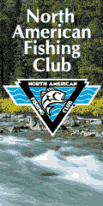

Free 90 day Risk free trial offer click
here

|
Rigging with Drift Control
By Ted Takasaki and Bob Riege
The edge of a specific structure is a great place to start looking for
fall walleyes. These edges form breaks, which almost act like
barriers to hold fish a little longer to feed before they move on.
These are physical boundaries between shallow food producing areas
and deep water areas of the lake. Here schools of active walleyes
meet concentrations of food and often this is a prime fishing area. By
fishing the edges of weeds, drop-offs and structure like rocks, you will
increase your chances of finding a funnel point where fish concentrate.
These spots vary but are based on factors like: water temperature,
availability of baitfish, oxygen, light level, structure and schooling
tendencies. Success rests with proper presentation. Once you
have located the edge and fish, the next step is to entice them to bite.
Your bait presentation will depend upon the specific edge that you have
selected. If the walleyes are directly below and concentrated
on a physical edge you can backtroll a livebait rig, jig, or use a
bottom bouncer rig, keeping the bait among the fish you see on the
depthfinder. If you find the fish strung out along the edge, keep
the bait moving and they will bite. If they're clumped up in one
spot, hover over them and vertically jig them. Rocks also attract fish,
try rocky shorelines. Rock piles, humps or where rocks and weeds
meet or are intermixed, work it over thoroughly with a jig or live bait
presentation. Try to determine where fish are
holding. Keep asking yourself the question what is their pattern?
Drifting the breakline on a windy day is a way to catch trophy walleyes.
The tackle is simple and the methods are easy to learn.
First, use jigs tipped with a crawler, leech or minnow. Terminal tackle
for a live bait rig usually includes a walking sinker threaded onto
the
line on top of a barrel swivel .
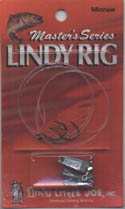 Traditional
Traditional
Lindy
Rig
|
Keep the sinker weight as light as possible, yet heavy enough to let
you feel the weight along the bottom. Usually 1/4 to 1/2 ounce sinkers
should be adequate for shallow water fishing From the opposite end of the
swivel run a 2 to 4 foot snell of 6 to 8 pound test monofilament.
Adjust the distance of your live-bait rig from the bottom according to
water clarity. In stained water the fish will be tight to the bottom
so the rig should run closer to the bottom. Just the opposite frequently
holds true in clear water |
I prefer to use the Lindy Rig in this case because it allows me the
versatility of getting the live bait right in the face of suspended walleyes.
A plain hook, or the new colored hooks are great, usually number 6 or number
8 finishes off the rig except for the bait.
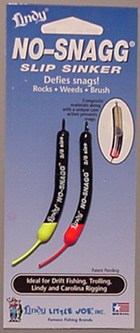
Lindy
No-Snagg Sinker |
The Lindy
No-Snagg Sinker replaces traditional slip sinkers. I want to
fish as vertically as possible and the Lindy No-Snagg on a 3-way swivel
gives me the control that I desire. The ability to maintain bottom
contact, sense of feel and interpret changes in bottom conditions is
essential for success. Lift and hold your sinker slightly off the bottom
most of the time,
keeping the bait near bottom and to feel the changes, such as transitions
from rock to sand or mud. Deep fish like to lie along changes in
bottom composition were the harder bottom of a dropoff joins the softer
bottom of the basin. Pay particular attention to such
changes along prominent points that gather walleyes.
This same technique can be applied to a vast majority of some of the
biggest and toughest walleye waters around. For example, the No-Snagg
Sinker can be used in heavy current like a river especially if you
are
concentrating on the rip rap. This slip sinker will work all
day long around the massive boulders. |
Pay particular attention to such changes along prominent points that gather
walleyes. This same technique can be applied to a vast majority of some
of the
biggest and toughest walleye waters around. For example, the
No-Snagg
Sinker can be used in heavy current like a river especially if you
are concentrating on the rip rap. This slip sinker will work all
day long around the massive boulders. The sinker will fall in between
the crevices and cracks where the walleyes fighting the current are resting
or waiting in ambush for their next meal. It works especially well
on Western and Southern big reservoirs where you have rock shale or stump
fields that were next to impossible to fish before.
To determine proper snell length, I keep a close eye on my Bottom Line
sonar unit. If the fish are detected three feet off the bottom,
try a snell length of 4 1/2 or 5 feet. If the fish are detected just
a foot or so up, drop down to an 18 or 20 inch snell. As I mentioned previously
the success of rigging is determined on your presentation. Boat control
becomes part of your presentation when you are rigging especially in windy
conditions. If the edges of structure
is where you want to fish then a Drift Control Sea Anchor helps me
stay
on the edges of this structure.
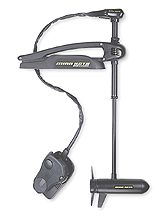
Minnkota 101 |

I operate my Ranger 620 from the bow with my Minnkota
101 Maxxum bow-mount motor. If I am following an inside turn,
or sitting on top of a break line I can maneuver my boat by using the drag
that I receive from the Drift Control Sea Anchor. |
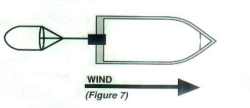
Use with you bow mounted electric
trolling motor by tying to the stern
of the boat. This adds more precise
boat control and allows you to follow
the contour of the shoreline or hold on
structure
 Sea Anchors Click
here to enter free drawing
Sea Anchors Click
here to enter free drawing
|
The Drift Control will allow
me to make subtle changes and I will not over steer my position.
To keep in contact with the specific structure I will deploy the sea anchor
off the stern of my Ranger boat. It gives the stern that added control
in windy and wavy conditions. Usually, I will tie the Drift Control
Sea Anchor off short so it will not interfere with fishing lines or the
netting of the fish, but still give me the added control of staying on
structure. |
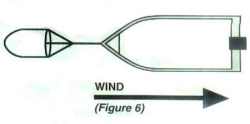
The Drift Control wind sock
Makes backtrolling more precise.
Tie the sock to the bow to prevent
swaying. You will enhance boat control
and fish your pattern not the winds.
If your motor fails in high winds tie the
sock to the bow using a long tow rope
and increase your safety by keeping the
bow headed into the wind |
If you are a backtroller and you want the same type of control rigging
then you will want to tie the Drift Control Sea Anchor off the bow of the
boat. It will prevent the bow from swinging in the wind and keep
you on the specific structure. Try this method when you are using
spinners along a breakline and you will see that you are fishing more than
steering. I prefer the Drift Control Sea Anchor over all the other drift
socks on the market today, because of the ease of deployment and the compact
method of storage. |
Using this in conjunction with the rigging methods
describe before and you will have a winning combination. Hope to see
you
soon on the water!
Fish
Clix Banner Exchange
Walleyes Inc. website is maintained
by Randy
Tyler Fishing the In-Fisherman Professional Walleye Circuit, Masters
Walleye Circuit and the Team Walleye Circuit. All rights reserved.Copyright
1999/2002
Please visit these site sponsors
Daiichi/Tru-Turn Hooks,
Lindy
Little Joe,
R-A.M Mounting Systems,
Ranger
boats, Mercury Outboards,
Bedford
Sales , Church Tackle, Panther
Marine Products,
Webfoots body sock,
Bait
Rigs Tackle ,Dual Pro Charging Systems,
Daiwa Rods and Reels,
Driftcontrol
Wind socks,
Trojan Batteries
|









